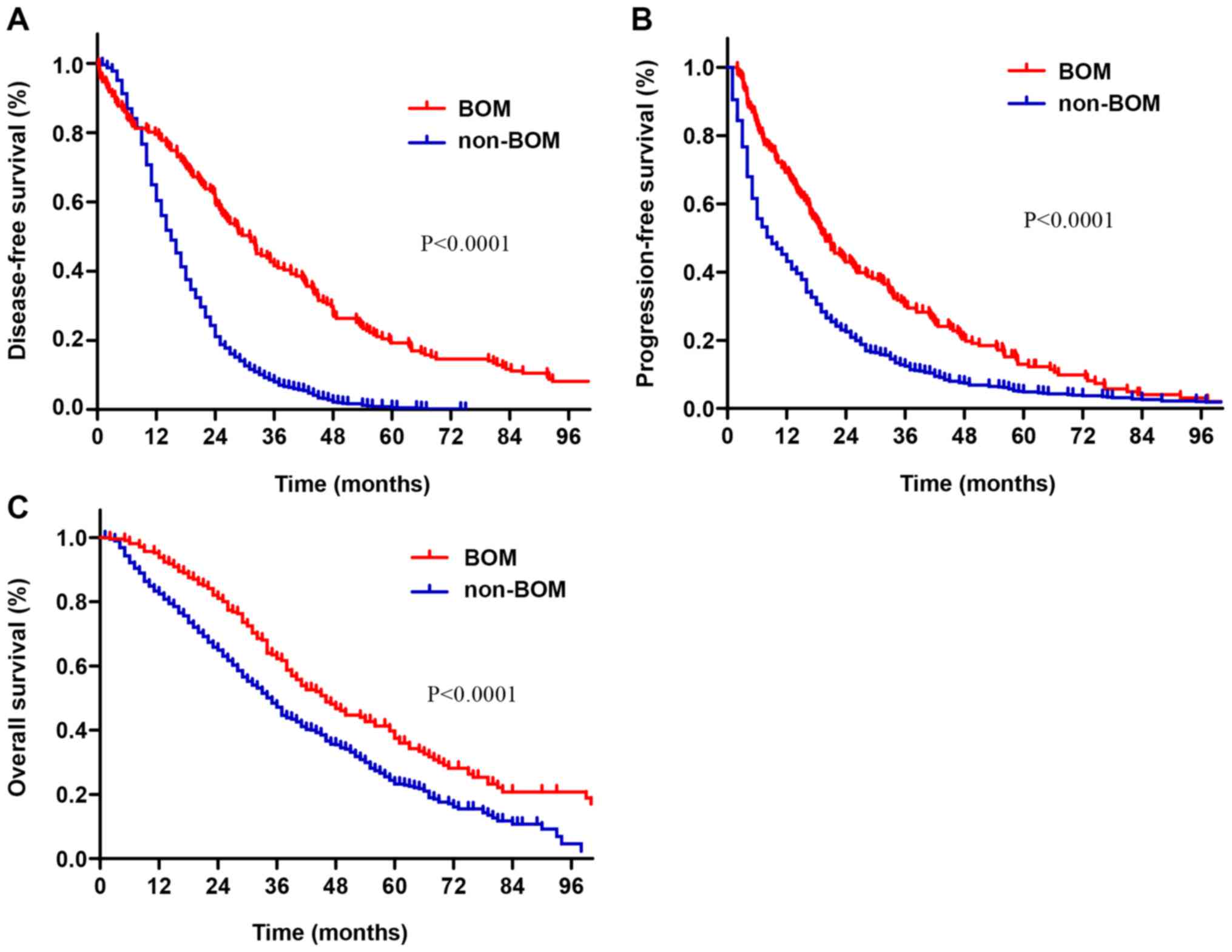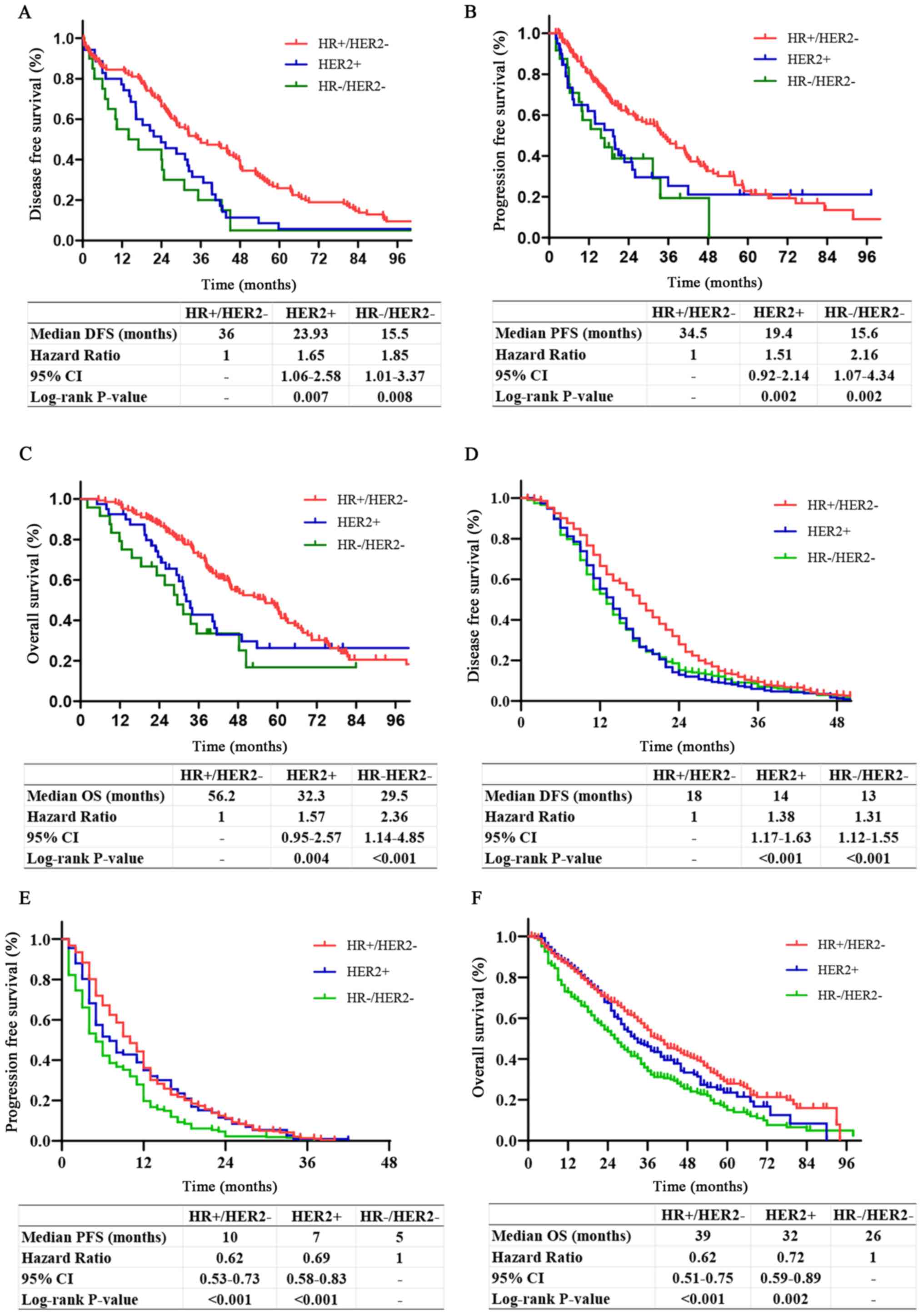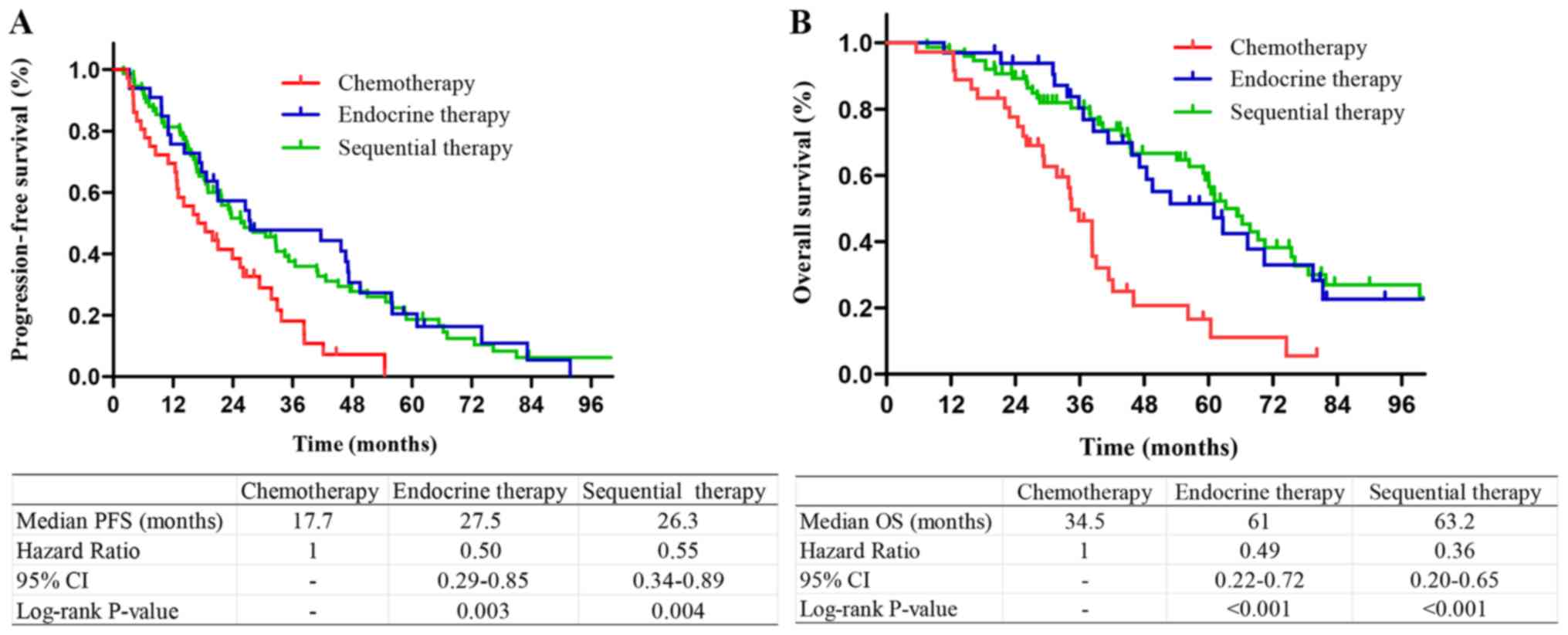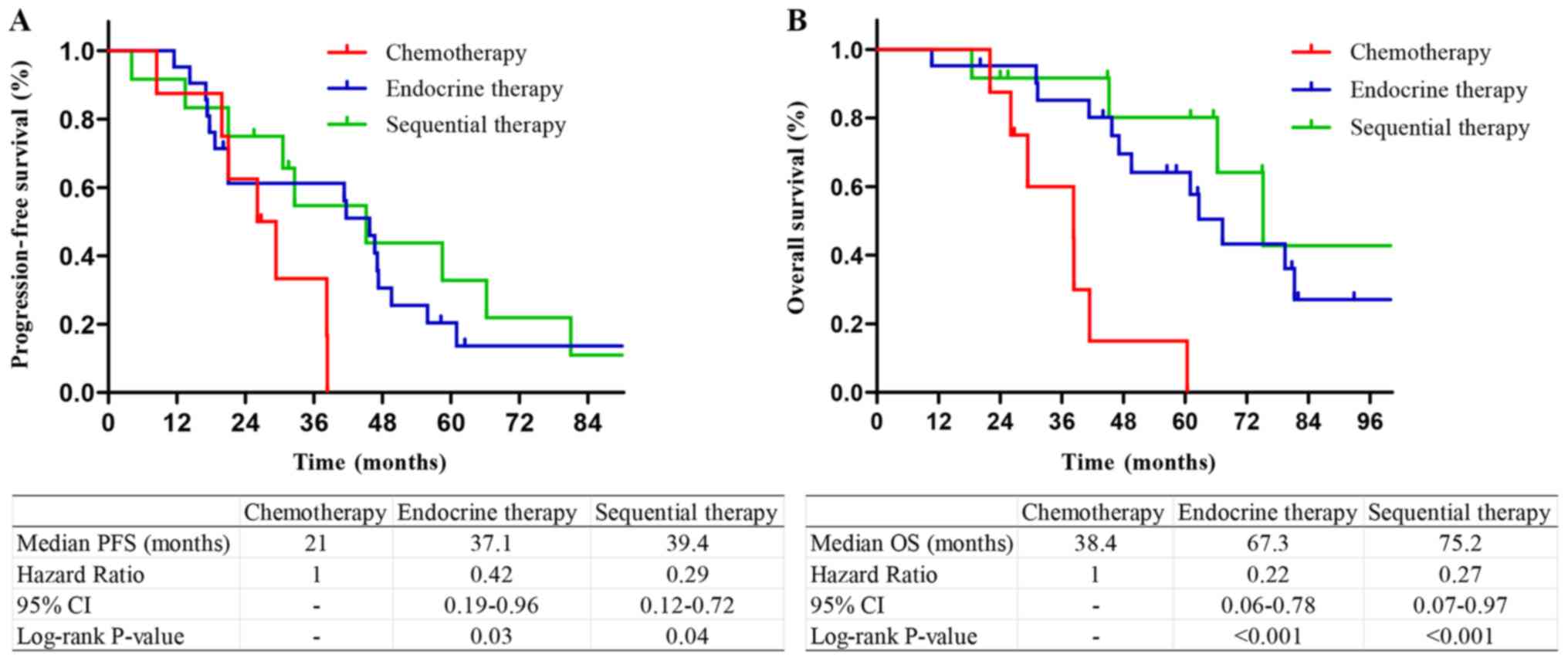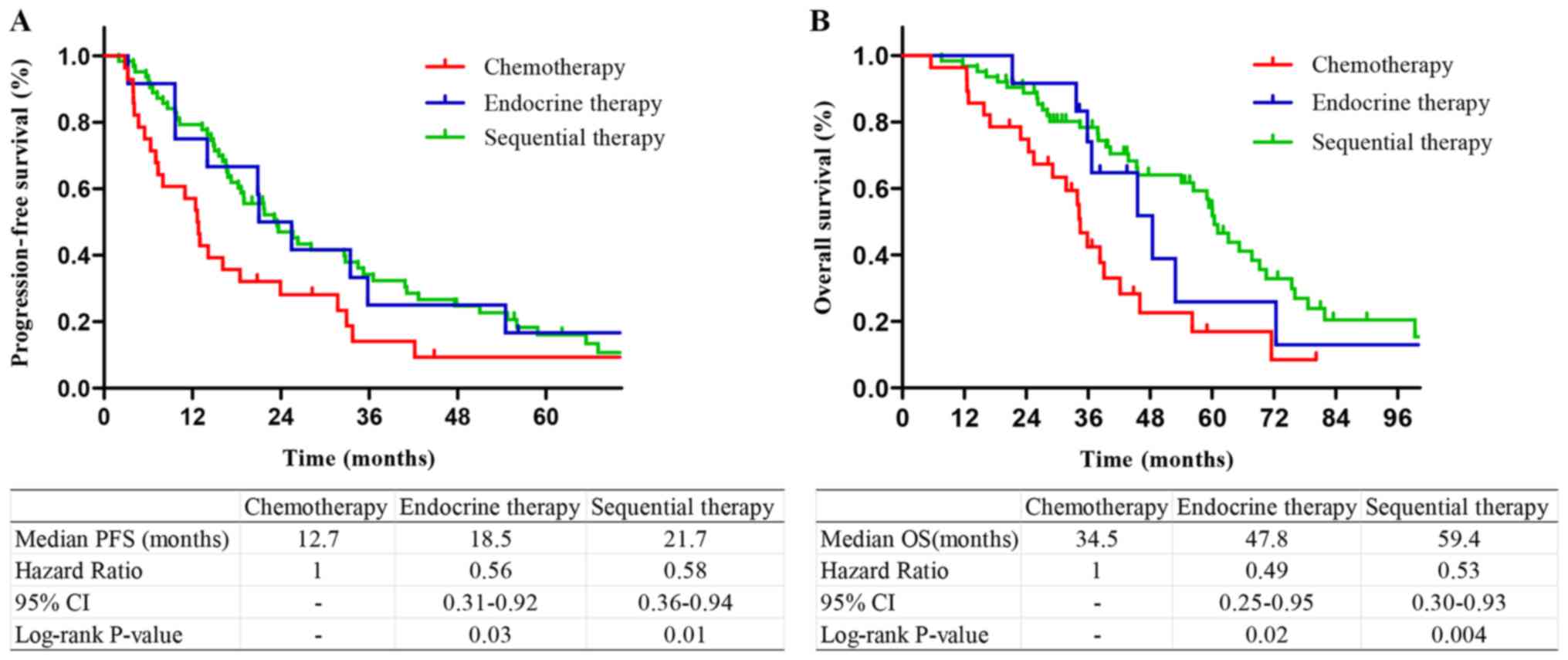|
1
|
Schröder J, Fietz T, Köhler A, Petersen V,
Tesch H, Spring L, Fleitz A, Jänicke M and Marschner N; TMK-Group
(Tumour Registry Breast Cancer, : Treatment and pattern of bone
metastases in 1094 patients with advanced breast cancer-Results
from the prospective German Tumour Registry Breast Cancer cohort
study. Eur J Cancer. 79:139–148. 2017. View Article : Google Scholar : PubMed/NCBI
|
|
2
|
Jin X and Mu P: Targeting breast cancer
metastasis. Breast Cancer (Auckl). 9 (Suppl 1):S23–S34. 2015.
|
|
3
|
Early Breast Cancer Trialists'
Collaborative Group (EBCTCG: Effects of chemotherapy and hormonal
therapy for early breast cancer on recurrence and 15-year survival,
. An overview of the randomised trials. Lancet. 365:1687–717. 2005.
View Article : Google Scholar : PubMed/NCBI
|
|
4
|
Manders K, van de Poll-Franse LV, Creemers
GJ, Vreugdenhil G, van der Sangen MJ, Nieuwenhuijzen GA, Roumen RM
and Voogd AC: Clinical management of women with metastatic breast
cancer: A descriptive study according to age group. BMC Cancer.
6:1792006. View Article : Google Scholar : PubMed/NCBI
|
|
5
|
Mulcrone PL, Campbell JP, Clément-Demange
L, Anbinder AL, Merkel AR, Brekken RA, Sterling JA and Elefteriou
F: Skeletal colonization by breast cancer cells is stimulated by an
osteoblast and β2AR-dependent Neo-angiogenic switch. J Bone Miner
Res. 32:1442–1454. 2017. View Article : Google Scholar : PubMed/NCBI
|
|
6
|
Coleman RE and Rubens RD: The clinical
course of bone metastases from breast cancer. Br J Cancer.
55:61–66. 1987. View Article : Google Scholar : PubMed/NCBI
|
|
7
|
Parkes A, Clifton K, Al-Awadhi A, Oke O,
Warneke CL, Litton JK and Hortobagyi GN: Characterization of bone
only metastasis patients with respect to tumor subtypes. NPJ Breast
Cancer. 4:22018. View Article : Google Scholar : PubMed/NCBI
|
|
8
|
von Moos R, Body JJ, Egerdie B, Stopeck A,
Brown J, Fallowfield L, Patrick DL, Cleeland C, Damyanov D, Palazzo
FS, et al: Pain and analgesic use associated with skeletal-related
events in patients with advanced cancer and bone metastases.
Support Care Cancer. 24:1327–1337. 2016. View Article : Google Scholar : PubMed/NCBI
|
|
9
|
Sathiakumar N, Delzell E, Morrisey MA,
Falkson C, Yong M, Chia V, Blackburn J, Arora T, Brill I and
Kilgore ML: Mortality following bone metastasis and
skeletal-related events among women with breast cancer: A
population-based analysis of U.S. Medicare beneficiaries,
1999–2006. Breast Cancer Res Treat. 131:231–238. 2012. View Article : Google Scholar : PubMed/NCBI
|
|
10
|
Li BT, Wong MH and Pavlakis N: Treatment
and prevention of bone metastases from breast cancer: A
comprehensive review of evidence for clinical practice. J Clin Med.
3:1–24. 2014. View Article : Google Scholar : PubMed/NCBI
|
|
11
|
Molnár IA, Molnár BÁ, Vízkeleti L, Fekete
K, Tamás J, Deák P, Szundi C, Székely B, Moldvay J, Vári-Kakas S,
et al: Breast carcinoma subtypes show different patterns of
metastatic behavior. Virchows Arch. 470:275–283. 2017. View Article : Google Scholar : PubMed/NCBI
|
|
12
|
Gong Y, Liu YR, Ji P, Hu X and Shao ZM:
Impact of molecular subtypes on metastatic breast cancer patients:
A SEER population-based study. Sci Rep. 7:454112017. View Article : Google Scholar : PubMed/NCBI
|
|
13
|
Solomayer EF, Diel IJ, Meyberg GC, Gollan
C and Bastert G: Metastatic breast cancer: Clinical course,
prognosis and therapy related to the first site of metastasis.
Breast Cancer Res Treat. 59:271–278. 2000. View Article : Google Scholar : PubMed/NCBI
|
|
14
|
Plunkett TA, Smith P and Rubens RD: Risk
of complications from bone metastases in breast cancer.
Implications for management. Eur J Cancer. 36:476–82. 2000.
View Article : Google Scholar : PubMed/NCBI
|
|
15
|
Ahn SG, Lee HM, Cho SH, Lee SA, Hwang SH,
Jeong J and Lee HD: Prognostic factors for patients with bone-only
metastasis in breast cancer. Yonsei Med J. 54:1168–1177. 2013.
View Article : Google Scholar : PubMed/NCBI
|
|
16
|
Niikura N, Liu J, Hayashi N, Palla SL,
Tokuda Y, Hortobagyi GN, Ueno NT and Theriault RL: Treatment
outcome and prognostic factors for patients with bone-only
metastases of breast cancer: A single-institution retrospective
analysis. Oncologist. 16:155–164. 2011. View Article : Google Scholar : PubMed/NCBI
|
|
17
|
Eckhardt BL, Francis PA, Parker BS and
Anderson RL: Strategies for the discovery and development of
therapies for metastatic breast cancer. Nat Rev Drug Discov.
11:479–497. 2012. View Article : Google Scholar : PubMed/NCBI
|
|
18
|
Erdogan B and Cicin I: Medical treatment
of breast cancer bone metastasis: From bisphosphonates to targeted
drugs. Asian Pac J Cancer Prev. 15:1503–1510. 2014. View Article : Google Scholar : PubMed/NCBI
|
|
19
|
Sze WM, Shelley M, Held I and Mason M:
Palliation of metastatic bone pain: Single fraction versus
multifraction radiotherapy-a systematic review of the randomised
trials. Cochrane Database Syst Rev. 2002:CD0047212004.
|
|
20
|
Hammond ME, Hayes DF, Dowsett M, Allred
DC, Hagerty KL, Badve S, Fitzgibbons PL, Francis G, Goldstein NS,
Hayes M, et al: American Society of Clinical Oncology/College of
American Pathologists guideline recommendations for
immunohistochemical testing of estrogen and progesterone receptors
in breast cancer. J Clin Oncol. 28:2784–2795. 2010. View Article : Google Scholar : PubMed/NCBI
|
|
21
|
Qian XL, Wen HY, Yang YL, Gu F, Guo XJ,
Liu FF, Zhang L, Zhang XM and Fu L: Assessment of dual-probe Her-2
fluorescent in situ hybridization in breast cancer by the 2013
ASCO/CAP guidelines produces more equivocal results than that by
the 2007 ASCO/CAP guidelines. Breast Cancer Res Treat. 159:31–39.
2016. View Article : Google Scholar : PubMed/NCBI
|
|
22
|
Tiedemann K, Hussein O and Komarova SV:
Role of altered metabolic microenvironment in osteolytic
metastasis. Front Cell Dev Biol. 8:4352020. View Article : Google Scholar : PubMed/NCBI
|
|
23
|
Xiong X, Zhang Z, Ren J, Zhang J, Pan X,
Zhang L, Gong S and Jin S: Impact of universal medical insurance
system on the accessibility of medical service supply and
affordability of patients in China. PLoS One. 13:e01932732018.
View Article : Google Scholar : PubMed/NCBI
|
|
24
|
Hu X, Li T, Wang B, Zhang J, Yu X and Shao
Z: Comparison of 4th ESO-ESMO international consensus guidelines
for advance breast cancer and Chinese anti-cancer association
committee of Breast Cancer Society guideline. Breast. 45:36–42.
2019. View Article : Google Scholar : PubMed/NCBI
|
|
25
|
Yamashiro H, Takada M, Nakatani E, Imai S,
Yamauchi A, Tsuyuki S, Matsutani Y, Sakata S, Wada Y, Okamura R, et
al: Prevalence and risk factors of bone metastasis and skeletal
related events in patients with primary breast cancer in Japan. Int
J Clin Oncol. 19:852–862. 2014. View Article : Google Scholar : PubMed/NCBI
|
|
26
|
Hölzel D, Eckel R, Bauerfeind I, Baier B,
Beck T, Braun M, Ettl J, Hamann U, Harbeck N, Kiechle M, et al:
Survival of de novo stage IV breast cancer patients over three
decades. J Cancer Res Clin Oncol. 143:509–519. 2017. View Article : Google Scholar : PubMed/NCBI
|
|
27
|
Miao H, Hartman M, Bhoo-Pathy N, Lee SC,
Taib NA, Tan EY, Chan P, Moons KG, Wong HS, Goh J, et al:
Predicting survival of de novo metastatic breast cancer in Asian
women: Systematic review and validation study. PLoS One.
9:e937552014. View Article : Google Scholar : PubMed/NCBI
|
|
28
|
Roodman GD: Mechanisms of bone metastasis.
N Engl J Med. 350:1655–1664. 2004. View Article : Google Scholar : PubMed/NCBI
|
|
29
|
Diessner J, Wischnewsky M, Stüber T, Stein
R, Krockenberger M, Häusler S, Janni W, Kreienberg R, Blettner M,
Schwentner L, et al: Evaluation of clinical parameters influencing
the development of bone metastasis in breast cancer. BMC Cancer.
16:3072016. View Article : Google Scholar : PubMed/NCBI
|
|
30
|
Zhang H, Zhu W, Biskup E, Yang W, Yang Z,
Wang H, Qiu X, Zhang C and Hu G and Hu G: Incidence, risk factors
and prognostic characteristics of bone metastases and
skeletal-related events (SREs) in breast cancer patients: A
systematic review of the real world data. J Bone Oncol. 11:38–50.
2018. View Article : Google Scholar : PubMed/NCBI
|
|
31
|
Park HS, Kim S, Kim K, Yoo H, Chae BJ, Bae
JS, Song BJ and Jung SS: Pattern of distant recurrence according to
the molecular subtypes in Korean women with breast cancer. World J
Surg Oncol. 10:42012. View Article : Google Scholar : PubMed/NCBI
|
|
32
|
Leone BA, Vallejo CT, Romero AO,
Machiavelli MR, Pérez JE, Leone J and Leone JP: Prognostic impact
of metastatic pattern in stage IV breast cancer at initial
diagnosis. Breast Cancer Res Treat. 161:537–548. 2017. View Article : Google Scholar : PubMed/NCBI
|
|
33
|
Metzger-Filho O, Sun Z, Viale G, Price KN,
Crivellari D, Snyder RD, Gelber RD, Castiglione-Gertsch M, Coates
AS, Goldhirsch A and Cardoso F: Patterns of Recurrence and outcome
according to breast cancer subtypes in lymph node-negative disease:
Results from international breast cancer study group trials VIII
and IX. J Clin Oncol. 31:3083–3090. 2013. View Article : Google Scholar : PubMed/NCBI
|
|
34
|
Soni A, Ren Z, Hameed O, Chanda D, Morgan
CJ, Siegal GP and Wei S: Breast cancer subtypes predispose the site
of distant metastases. Am J Clin Pathol. 143:471–478. 2015.
View Article : Google Scholar : PubMed/NCBI
|
|
35
|
Beca F, Santos R, Vieira D, Zeferino L,
Dufloth R and Schmitt F: Primary relapse site pattern in women with
triple-negative breast cancer. Pathol Res Pract. 210:571–575. 2014.
View Article : Google Scholar : PubMed/NCBI
|
|
36
|
Domchek SM, Younger J, Finkelstein DM and
Seiden MV: Predictors of skeletal complications in patients with
metastatic breast carcinoma. Cancer. 89:363–368. 2000. View Article : Google Scholar : PubMed/NCBI
|
|
37
|
Lipton A: Should bisphosphonates be
utilized in the adjuvant setting for breast cancer. Breast Cancer
Res Treat. 122:627–636. 2010. View Article : Google Scholar : PubMed/NCBI
|
|
38
|
Chen MT, Sun HF, Zhao Y, Fu WY, Yang LP,
Gao SP, Li LD, Jiang HL and Jin W: Comparison of patterns and
prognosis among distant metastatic breast cancer patients by age
groups: A SEER population-based analysis. Sci Rep. 7:92542017.
View Article : Google Scholar : PubMed/NCBI
|
|
39
|
James JJ, Evans AJ, Pinder SE, Gutteridge
E, Cheung KL, Chan S and Robertson JF: Bone metastases from breast
carcinoma: Histopathological-radiological correlations and
prognostic features. Br J Cancer. 89:660–655. 2003. View Article : Google Scholar : PubMed/NCBI
|
|
40
|
Williams MR, Todd JH, Ellis IO, Dowle CS,
Haybittle JL, Elston CW, Nicholson RI, Griffiths K and Blamey RW:
Oestrogen receptors in primary and advanced breast cancer: An eight
year review of 704 cases. Br J Cancer. 55:67–73. 1987. View Article : Google Scholar : PubMed/NCBI
|
|
41
|
Koizumi M, Yoshimoto M, Kasumi F and Ogata
E: Comparison between solitary and multiple skeletal metastatic
lesions of breast cancer patients. Ann Oncol. 14:1234–1240. 2003.
View Article : Google Scholar : PubMed/NCBI
|
|
42
|
Parkes A, Warneke CL, Clifton K, Al-Awadhi
A, Oke O, Pestana RC, Alhalabi O, Litton JK and Hortobagyi GN:
Prognostic factors in patients with metastatic breast cancer with
bone-only metastases. Oncologist. 23:1282–1288. 2018. View Article : Google Scholar : PubMed/NCBI
|
|
43
|
Henry DH, Costa L, Goldwasser F, Hirsh V,
Hungria V, Prausova J, Scagliotti GV, Sleeboom H, Spencer A,
Vadhan-Raj S, et al: Randomized, double-blind study of denosumab
versus zoledronic acid in the treatment of bone metastases in
patients with advanced cancer (excluding breast and prostate
cancer) or multiple myeloma. J Clin Oncol. 29:1125–1132. 2011.
View Article : Google Scholar : PubMed/NCBI
|
|
44
|
Coleman RE: Impact of Bone-targeted
treatments on skeletal morbidity and survival in breast cancer.
Oncology (Williston Park). 30:695–702. 2016.PubMed/NCBI
|
|
45
|
Biskup E, Cai F and Vetter M: Bone
targeted therapies in advanced breast cancer. Swiss Med Wkly.
147:W144402017.PubMed/NCBI
|
|
46
|
Purushotham A, Shamil E, Cariati M, Agbaje
O, Muhidin A, Gillett C, Mera A, Sivanadiyan K, Harries M, Sullivan
R, et al: Age at diagnosis and distant metastasis in breast
cancer-a surprising inverse relationship. Eur J Cancer.
50:1697–1705. 2014. View Article : Google Scholar : PubMed/NCBI
|
|
47
|
Hung MH, Liu CY, Shiau CY, Hsu CY, Tsai
YF, Wang YL, Tai LC, King KL, Chao TC, Chiu JH, et al: Effect of
age and biological subtype on the risk and timing of brain
metastasis in breast cancer patients. PLoS One. 9:e893892014.
View Article : Google Scholar : PubMed/NCBI
|
|
48
|
Ren Z, Li Y, Hameed O, Siegal GP and Wei
S: Prognostic factors in patients with metastatic breast cancer at
the time of diagnosis. Pathol Res Pract. 210:301–306. 2014.
View Article : Google Scholar : PubMed/NCBI
|
|
49
|
Jung SY, Rosenzweig M, Sereika SM, Linkov
F, Brufsky A and Weissfeld JL: Factors associated with mortality
after breast cancer metastasis. Cancer Causes Control. 23:103–112.
2012. View Article : Google Scholar : PubMed/NCBI
|
|
50
|
Cossetti RJ, Tyldesley SK, Speers CH,
Zheng Y and Gelmon KA: Comparison of breast cancer recurrence and
outcome patterns between patients treated from 1986 to 1992 and
from 2004 to 2008. J Clin Oncol. 33:65–73. 2015. View Article : Google Scholar : PubMed/NCBI
|
|
51
|
Laohavinij S, Paul V and Maneenil K:
Survival and prognostic factors of metastatic breast cancer. J Med
Assoc Thai. 100 (Suppl 1):S16–S26. 2017.PubMed/NCBI
|
|
52
|
Ignatov A, Eggemann H, Burger E and
Ignatov T: Patterns of breast cancer relapse in accordance to
biological subtype. J Cancer Res Clin Oncol. 144:1347–1355. 2018.
View Article : Google Scholar : PubMed/NCBI
|
|
53
|
Press DJ, Miller ME, Liederbach E, Yao K
and Huo D: De novo metastasis in breast cancer: Occurrence and
overall survival stratified by molecular subtype. Clin Exp
Metastasis. 34:457–465. 2017. View Article : Google Scholar : PubMed/NCBI
|
|
54
|
Yamashiro H, Takada M, Nakatani E, Imai S,
Yamauchi A, Tsuyuki S, Matsutani Y, Sakata S, Wada Y, Okamura R, et
al: Prevalence and risk factors of bone metastasis and skeletal
related events in patients with primary breast cancer in Japan. Int
J Clin Oncol. 19:852–862. 2014. View Article : Google Scholar : PubMed/NCBI
|
|
55
|
Kuchuk I, Hutton B, Moretto P, Ng T,
Addison CL and Clemons M: Incidence, consequences and treatment of
bone metastases in breast cancer patients-Experience from a single
cancer Centre. J Bone Oncol. 2:137–144. 2013. View Article : Google Scholar : PubMed/NCBI
|
|
56
|
Ma R, Feng Y, Lin S, Chen J, Lin H, Liang
X, Zheng H and Cai X: Mechanisms involved in breast cancer liver
metastasis. J Transl Med. 13:642015. View Article : Google Scholar : PubMed/NCBI
|
|
57
|
Wei S and Siegal GP: Metastatic
organotropism: An intrinsic property of breast cancer molecular
subtypes. Adv Anat Pathol. 24:78–81. 2017. View Article : Google Scholar : PubMed/NCBI
|















